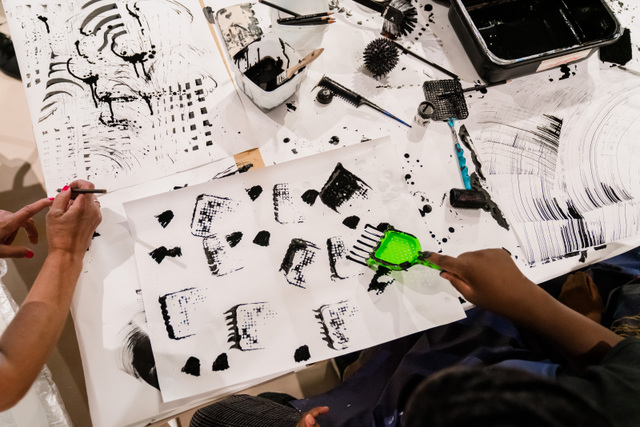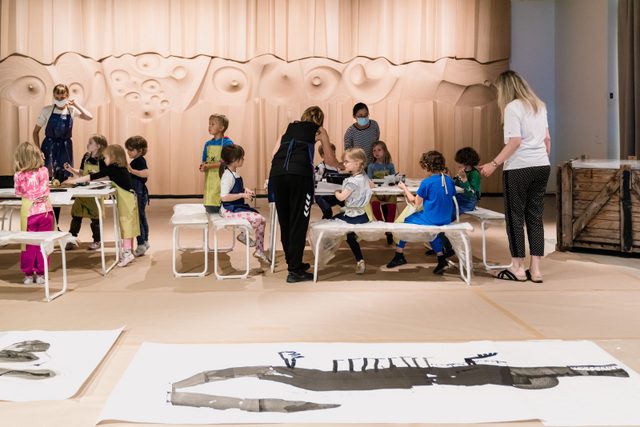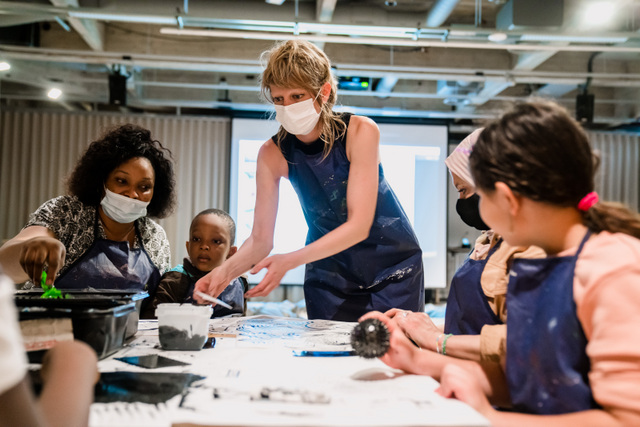
Laura Merz on rich, black lines and the power of intuition
Created with Emma – Espoo Museum of Modern Art
The Tapiola neighborhood comes alive this autumn as artist and illustrator Laura Merz collaborates with a vibrant group of children to decorate a construction hoarding surrounding the building site of the new daycare centre.
The Zoom connection crackles a little as Laura Merz, artist and illustrator, pops up on the screen from her studio somewhere in Berlin. The artist smiles, life has been busy of late. Several public artworks are coming to life around Finland, namely, in the Central Library in Riihimäki, the coastal town of Hanko and now in Tapiola. The latter being a collaboration between the City of Espoo, the architectural design agency Innovarch, and EMMA – Espoo Museum of Modern Art.
The project, involving a replacement of the now-demolished Metsola day-care centre with a new, wooden building in the municipality of Espoo, is classic Merz: curious, whimsical and collaborative. Divided into two working phases, it involves the cooperative decorating of the hoarding surrounding the construction site while, upon the building’s completion, a selection of other works by Merz will be integrated within the architecture of the new building. Conclusively, Merz’s hoarding design will be accessioned to the collection of EMMA.
“I felt very honoured to be selected as the artist for the project,” Merz concludes.

An ensemble of work which came with a wish for a collaborative component, something which Merz decided to establish in cooperation with a group of local children, i.e. the customers of day-care centres and All Our Children (Yhteiset Lapsemme ry), a Finnish non-profit organization that aims to promote and protect the welfare and rights of immigrant children and children of ethnic minorities.
The project can now be visited at Kelohongantie 6 in Espoo.
“Working with children is fun,” the artist laughs, “I find it inspiring to see how kids approach art making.”
Merz’s own approach involved a combination of innocence and intuition. For example, the tools used in working with, both the construction hoarding and the integrated artwork, involved a curious mix of basically anything one could find. A medley of cleaning devices and gadgets, pieces of plastic and other items of no significant monetary value – things that, according to Merz, allow for more simplistic and rougher processes. “I don’t tend to work with fancy equipment or expensive paper,” she says, “I prefer items that encourage me to work through mishaps.”
“To me, mishaps and mistakes bring us to places where new and interesting can be found.”
The artist describes herself as a perfectionist, a person so involved in work that she will – and tends to – keep on working at it until the bitter end. Something which Merz continuously tries to counteract. “I am, at all times, trying to work in ways that are more emotion-based, more intuitive-driven.”
This means that the artist often begins by choosing simple tools to work with. An act which in itself allows for Merz to fool their own mind into working faster, more carefree. “I tend to go for running ink and start my work using mark making techniques. I find that ink as a material creates colours that are very satisfying. Rich, dark blacks and watercolour-like greys.”
Tools and materials which create forms that are beautiful which to Merz means that they are somewhat surprising, new and less rigid. Something to silence the inner critic. “Working in a more careless, slightly reckless way allows me to forgo the inner voice that so easily sabotages the creative process. A voice always there, nagging at me. Insisting on things not being possible, that I might not be good enough or that there will never be enough time to take risks in the drawing process.”
While time often is of the essence, the artist finds it “calming to work through very abstract lines in the beginning, to first approach the piece at hand by not trying to create anything figurative”.
Particularly as the artist is often commissioned to work with illustrations depicting animals. “Working with these types of forms and figures, I find it best to try and find myself in a calm mindset.” So to get there, Merz goes for the abstract. “I draw aimlessly with no regard to the end product. In fact, what I produce are mainly blotches of ink.” Blotches that can then, as the mind relaxes and starts working in more imaginative ways, reform into anything. Elephants that morph from wet blacks, seals from slow, runny greys.

“The mind becomes sensitised and starts seeing things that a stressed brain ignores.”
When depicting animals, Merz does not aim for a realistic visual language but prefers a drawing style that is minimal, yet expressive. “I try to capture the most essential – the energy of animals, the way I have perceived it through personal encounters as well as images, stories and myths about them.”
For those possibly thinking that simplicity or the quest for innocence sounds like a quick and easy way of working, Merz responds with a strict “no”. The work itself is never fast. The processes leading to minimal, yet well-thought lines and forms take time. Time and endless amounts of paper and ink.
“One of the most challenging aspects of working creatively is getting to that state where constraints lose their meaning,” Merz explains, “a state which is only possible if there is enough time to fail, to end up with mishaps – to be able to find your way intuitively.”
A flow, a relaxed hand and a mind that seeks its way back to memories. Recollections of animals, nature and childhood. Thin lines tracing the outlines of furry things, wild things.
Such as those depicted together with the local children, now creeping the construction fences surrounding the new day care centre, climbing the walls in Tapiola – and possible other public spaces as a part of the EMMA Collection.
Visit Metsola, the daycare centre and its construction hoarding:
Address: Kelohongantie 6, 02120 Espoo
Visit EMMA – Espoo Museum of Modern Art:
Address: Ahertajantie 5, 02100 Espoo
EMMA – Espoo Museum of Modern Art with its 5000 square metre exhibition space, it is the largest art museum in the whole of Finland.